How to Grill Frozen Steaks
What if you could take steaks directly from the freezer to the grill, and have perfect results on the table in only 30-40 minutes? If you do it the right way, you may even find you prefer this method. More and more chefs are recommending cooking frozen steaks, and we’ve got the key temperatures to help you understand how to grill them right.
Why Grill A Frozen Steak?
➤ A Dinner-Planning Time Saver for Busy Weeknights
Grilling is a quick cooking method that is ideal for whipping up a quick meal any night of the week. But what if you forgot to pull the meat from your freezer, or still haven’t planned dinner? And if unexpected guests pop in, this is a perfect go-to meal plan in a pinch.
The thought of taking a rock-solid piece of frozen meat and placing it on a ripping-hot grill seems contradictory to traditional cooking, but it is a well-vetted method.
➤ More Perfect From Edge to Edge
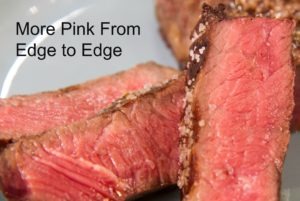
 At 140°F, protein fibers begin to…
At 140°F, protein fibers begin to…
- Shrink and tighten
- Squeeze out their water and become dry
- Develop a brown/grey color, or a “grey band”
After searing, the full interior of the meat continues to warm, reaching its pull temperature more gradually, resulting in little to no grey band and more edge-to-edge pink perfection. Less overcooked meat means a juicier steak to eat.
3 IMPORTANT FACTORS FOR GRILLED, FROZEN STEAK SUCCESS:
The tireless investigative culinary team at Cook’s Illustrated tackled this project as described in their article, Spur of the Moment Grilled Steaks. We found 3 major keys to this cook that are all entirely thermal…
- Use indirect heat with a two-zone fire setup
- The steaks need to be thick
- Temperature tracking with an instant-read thermometer like a Thermapen®® Mk4.
1. Indirect Heat
Setting up a two-zone fire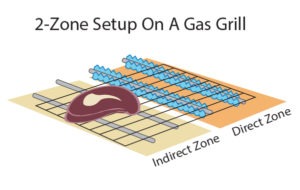
The direct heat side of the grill will be about 500-700°F (260-371°C) on its surface, with grease flare-ups possibly reaching temperatures as high as 2,500-3,000°F (1,371-1,649°C)! The indirect heat side of the grill will maintain a far more moderate temperature similar to roasting—about 300-350°F (149-177°C).
* For more information on the high temperatures of grilling, read our post: The Difference Between Grilling and BBQ.
2. Thick Steaks
It would seem that thinly sliced meat might be more appropriate to quickly thaw and cook over high heat. The low freezing temperature of the meat requires more thermal energy (more time over the heat source) for the Maillard reaction to occur. The frozen steaks will start out at about 32°F (0°C) and will need to reach a temperature of about 350°F (177°C) for the Maillard reaction to be most effective.
Thinner steaks do indeed thaw more quickly, but the interior becomes completely overcooked and dry by the time the exterior is able to reach a high enough searing temperature. Stick to thick-cut steaks.
3. Temperature Tracking
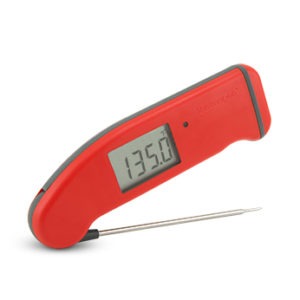
How To Cook A Frozen Steak: Recipe
Get ready to take your steaks from frozen to 125°F ([52°C]for medium rare) in 40 minutes!
Ingredients
- 1 to 1-1/2 inch thick frozen steaks (rib eye, porterhouse, new york strip, etc.)
- Kosher salt and pepper
- (Kosher salt adheres more readily to food than granulated table salt and it can be a challenge to get the salt to adhere using this method)
☼ Tip: The way that you freeze the steaks in the first place can have an impact on your success. Be sure to place the steaks onto a flat surface like a sheet pan before putting them into the freezer. The frozen sides of the steak will have more direct contact with the grill grate for a better sear if they are flat.
We lined our sheet pans with parchment paper to keep the steaks from adhering to the sheet pans and left them uncovered until they were fully frozen. Leaving the steaks uncovered allows moisture on the surface of the steaks to evaporate, keeping them drier. Dry steaks will sear better. After the steaks were fully frozen (about 5 hours) we transferred them to zipper-seal bags for long-term storage.
Get Fired-Up
- Prepare charcoal or gas grill with a two-zone fire setup. Allow to heat for about 15 minutes for a charcoal grill, and 5 minutes for a gas grill for the heat to be high enough for searing the steaks (read more on the high temperatures involved in grilling in our post, The Difference Between Grilling and BBQ).
- Brush grill grate completely clean after heating and before proceeding with the cook.
Get Cooking
? 10-14 Minutes Over Direct Heat
- Pull steaks directly from the freezer and place over direct heat side of the grill. Sear steaks for about 5-7 minutes on each side for proper development of a crisp, brown crust.
? 10-15 Minutes Over Indirect Heat
- At this point, the internal temperature of the steak will be in the range of 70-90°F (21-32°C). Move the steaks to the indirect-heat side of the grill and season with salt and pepper on each side.
- The steaks should be approximately 6 inches (15 cm) from the primary, direct burner.
- It’s important to season the steaks after searing because the salt and pepper will not adhere to the frozen meat. Since kosher salt adheres to food better and dissolves more quickly than table salt, it’s a must for seasoning with this cooking method.
? 5 Minutes for Resting
- Cook until the steaks reach their internal pull temperature for your desired doneness. We pulled ours at 125°F (52°C) for a final medium rare doneness temperature of 130°F (54°C). Spot-check internal temperatures with an instant-read digital thermometer like the new, faster ThermoPop (readings in 3-4 seconds!). See the table below:
Pull Temperatures and Final Doneness Temperatures for Steaks
☼ Thermal Tip: For more information on how to accurately check the internal temperature of a steak, check out our post, How to Temp a Steak: Getting it Right.
- Allow steaks to rest for 5 minutes before serving.
To Recap:
Grilled Frozen Steak Success:
Two-zone fire setup with a gas or charcoal grill
- Sear over high, direct heat for 5-7 minutes each side
- Move to lower, indirect heat and season with salt and pepper
Pull and Doneness Temperatures:
- Pull Temps—Continue cooking and pull from the grill when steaks reach their pull temperature of 120-125°F (49-52°C) (as verified when spot-checking the thermal center with a Thermapen) for medium rare or 130-135°F (54-57°C) for medium doneness.
- Doneness Temps—Rest for 5 minutes to allow steaks to relax and reabsorb juices and allow carryover cooking to increase the final doneness temperatures to 125-130°F (52-54°C) for medium rare or 135-140°F (57-60°C) for medium.
Grilled, frozen steaks will be a welcome and stress-free addition to your dinner menu repertoire. Once the steaks are done, serve as-is or slice thinly for tacos, on top of mixed greens, or a Philly cheesesteak sandwich with your favorite sides. Stock up on steaks, and mind your temps.
Products Used:
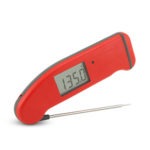
Resources, and for more information:
Spur of the Moment Grilled Steaks, Cook’s Illustrated
Low-Temp Oven Steak, Modernist Cuisine (Nathan Myhrvold)
Sorcerer’s Apprentice Hosts a Dinner, Melissa Clark, The New York Times


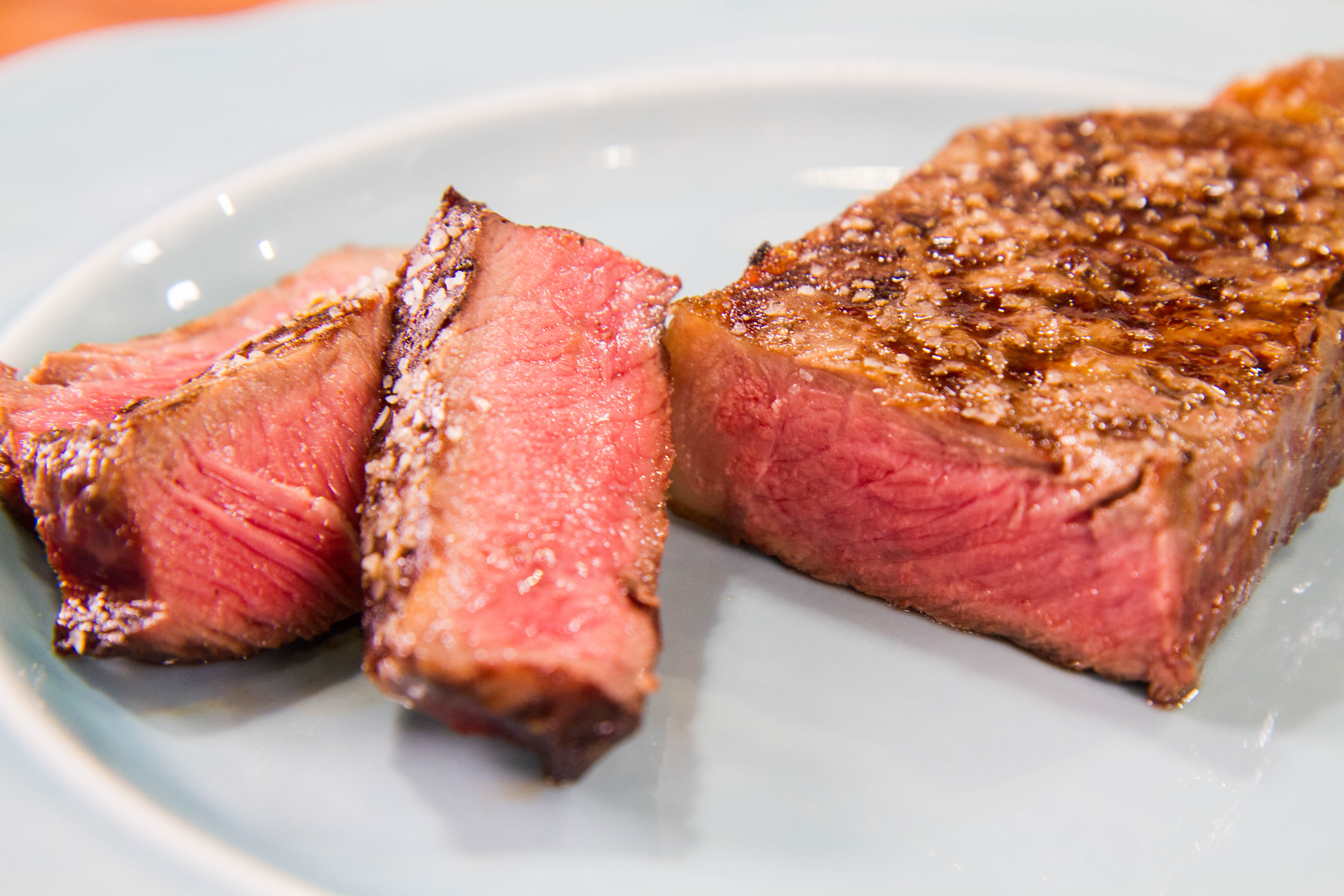
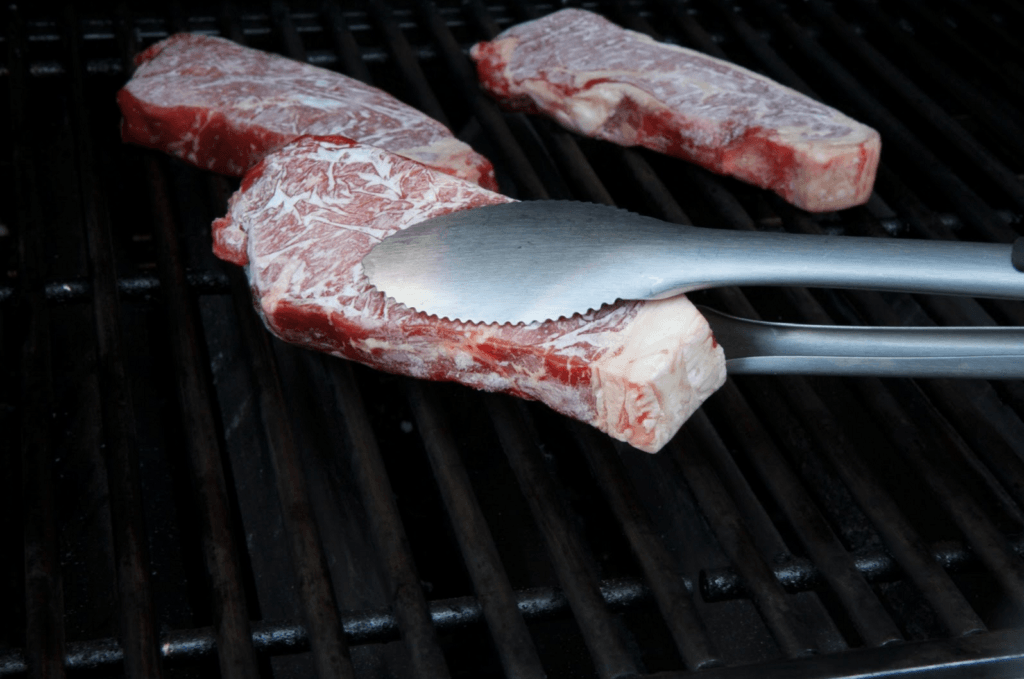
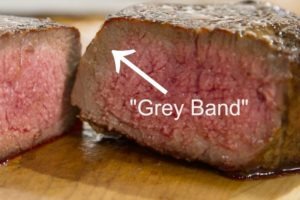
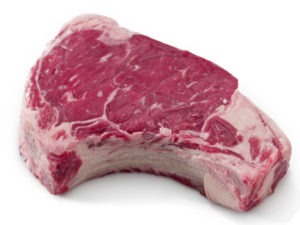





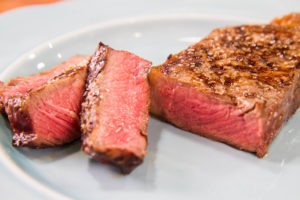 Two-zone fire setup with a gas or charcoal grill
Two-zone fire setup with a gas or charcoal grill
I agree with the concept, in fact, when I have steaks less than 1.5-inches thick, if they are frozen, I will cook directly from the freezer; and if they are not frozen, I will put them into the freezer for at least 1/2 hour to get core temperature as low as possible. When I differ, I cook over directly heat only. For steaks thicker than 1.5-inches, reverse searing using my thermometer to follow temperature. Since I started cooking thinner steaks directly from the freezer and or chilled in freezer before cooking, we have been able to enjoy all of our steaks medium-rare.
Robert,
It’s fun to play around with different cooking techniques, and we were very pleased with these results. Freezing the meat really does make a difference in being able to achieve a great sear while avoiding an overcooked grey band. Thank you for sharing how you apply freezing for your perfect steaks!
-Kim
Thank you for info.
Wayne,
You’re welcome! This is a fun concept, and it’s always great to have new cooking methods to try. Thank you for commenting.
-Kim
I love these cooking posts. Great suggestions with precise directions are helping me to up my grilling game. I discovered Thermoworks only six months ago and you’re now one of my favorite cooking tools.
Anne,
Thank you for your comment! I’m pleased to hear you’re enjoying our products. Stay subscribed so you can stay up to date on new products and projects we have in the works.
Happy Cooking!
-Kim
Your links to the Cook’s Illustrated article are broken.
Harron,
Thank you for bringing this to our attention. We’re currently working to fix the problem. Until then you can search the Cook’s Illustrated website for Spur of the Moment Grilled Steaks, or copy and paste this URL: https://www.cooksillustrated.com/articles/253-spur-of-the-moment-grilled-steak
My apologies, and thank you again.
-Kim
On thing I find making steak that works very well is to salt the steaks at least half an hour before cooking them. The salt pulls moisture out then the salty moister is reabsorbed, seasoning te staeks much deeper.
Maybe salting them and giving them a half hour on a rack to absorb the salt before freezing seems like it would work very well.
Doug,
I think that sounds like a great idea. I wholeheartedly agree that dry brining is worth the time and effort. Great tip!
Thanks,
-Kim
I have been doing my steaks and burgers straight from the freezer for years. The difference is that I use the smoker instead of my grill for everything these days. The sear from the grill is nice but the deeper smoke flavor more then makes up for it and you can use thin cuts without a problem if that is what you have on hand. My ThermoPen and ThermoPops make it easy to hit the target every time.
CaptTurbo,
You can’t go wrong using a smoker for lower temp cooks! It’s definitely a great way to go anytime a two-stage cook is needed. Glad to hear your Thermapen and ThermoPops are serving you well.
Thank you for your comment!
-Kim
Using my Thermoworks infrared thermometer I have recorded 600 degrees in a cast iron grill pan on the stove’s high power burner. Once seared can’t the steak go unto the oven for the 350 degree finish? I have my thermapen ready to check for 120 internal.
In other words, shouldn’t I be able to cook from frozen indoors, too?
Jeff,
Yes! You can sear on and finish on the grill, or pan sear and finish in the oven. Either way, it’s a great method to try. Check out this video on cooking frozen steaks from Cook’s Illustrated: https://www.youtube.com/watch?v=uLWsEg1LmaE
Thanks for your comment!
-Kim
I gave it a shot with a ribeye. After about 4 min. a side in a 530 pan the inside was still frozen. I partially covered the pan with a lid to hold more heat. After another 2 min. a side I had all the sear I wanted but it was still frozen inside. I moved the steak to a pre heated 350 oven and pulled it at 120 internal. I tented it with foil for five minutes. The results were amazing. It was a perfect pink right out to the sear. There was virtually no transition gray. There was a little unevenness varying from rare to medium rare but in our house that is all good . This is the way to go. Thanks.
Jeff,
Thank you for giving us the details of your cook! It sounds like you had perfect results with your ribeye. It’s amazing what a difference this straight from the freezer method makes with edge to edge pink results.
Thanks again for your comment!
-Kim
Did it, loved it. Colorado ribeye. Took awhile though,it was about 2 inches.
Have been using this method for the past 6 mos. It’s a great way to whip up a quick savory dinner. I usually Sear and turn the steak to get that awesome cross hatching, then move to the indirect side. Tip—if you like cross hatching, you can reduce the sear time by about 2-3 min/side.